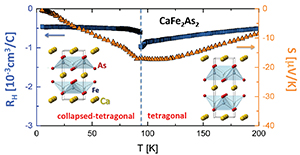ORNL paper examines clues for superconductivity in an iron-based material

A change of Hall and Seebeck effects point to large Fermi surface modification at the structural transition, preventing superconductivity at low temperatures. The change in the Fermi surface topology has been confirmed by angle-resolved photoemission spectroscopy.
The paper, published in Physical Review Letters, focuses on a calcium-iron-arsenide single crystal, which has structural, thermodynamic and transport properties that can be varied through carefully controlled synthesis, similar to the application of pressure. To make this discovery, researchers focused on how these changes alter the material’s Fermi surface, which maps the specific population and arrangement of electrons in materials.
“The Fermi surface is basically the ‘genetic code’ for causing a certain property, including superconductivity, in a material,” said Athena Safa-Sefat of the Department of Energy’s Oak Ridge National Laboratory, which led the research team.
“We can make different phases of this material in single crystal forms and measure their structure and properties, but now we have Fermi surface signatures that explain why we can't induce superconductivity in a certain structural phase of this material.”
Superconducting wires conduct electricity without resistance and could save the nation billions of dollars per year by virtually eliminating transmission losses on the grid, or they can be used to make compact, light and powerful motors and generators. This particular material is of special interest because it adds critical knowledge to the field of superconductivity that will ultimately allow such widespread applications.
The lead author of this paper, Krzysztof Gofryk, who did this work as a post-doctoral fellow at ORNL, showed how the interplay of structure and magnetism affected the Fermi surface and hence the electronic properties.
In calcium-iron-arsenide, the bulk superconducting state is absent because of the large Fermi surface modification at the structural transition.
This work represents a significant step forward for understanding this material's rich phase diagram and causes of superconductivity, Sefat said.
Other authors of the paper, titled “Fermi-Surface Reconstruction and Complex Phase Equilibria in CaFe2As2,” are ORNL’s post-doctoral fellow Bayrammurad Saparov and scientists from Los Alamos National Laboratory and Dresden University of Technology. The paper is available at http://arxiv.org/abs/1404.1095.
This research was funded by DOE’s Office of Science and by LANL’s Laboratory Directed Research and Development program.
UT-Battelle manages ORNL for the Department of Energy’s Office of Science. DOE’s Office of Science is the single largest supporter of basic research in the physical sciences in the United States, and is working to address some of the most pressing challenges of the time. For more information, please visit href=”http://arxiv.org/abs/1404.1095″.
Media Contact
All latest news from the category: Materials Sciences
Materials management deals with the research, development, manufacturing and processing of raw and industrial materials. Key aspects here are biological and medical issues, which play an increasingly important role in this field.
innovations-report offers in-depth articles related to the development and application of materials and the structure and properties of new materials.
Newest articles

A universal framework for spatial biology
SpatialData is a freely accessible tool to unify and integrate data from different omics technologies accounting for spatial information, which can provide holistic insights into health and disease. Biological processes…

How complex biological processes arise
A $20 million grant from the U.S. National Science Foundation (NSF) will support the establishment and operation of the National Synthesis Center for Emergence in the Molecular and Cellular Sciences (NCEMS) at…

Airborne single-photon lidar system achieves high-resolution 3D imaging
Compact, low-power system opens doors for photon-efficient drone and satellite-based environmental monitoring and mapping. Researchers have developed a compact and lightweight single-photon airborne lidar system that can acquire high-resolution 3D…





















